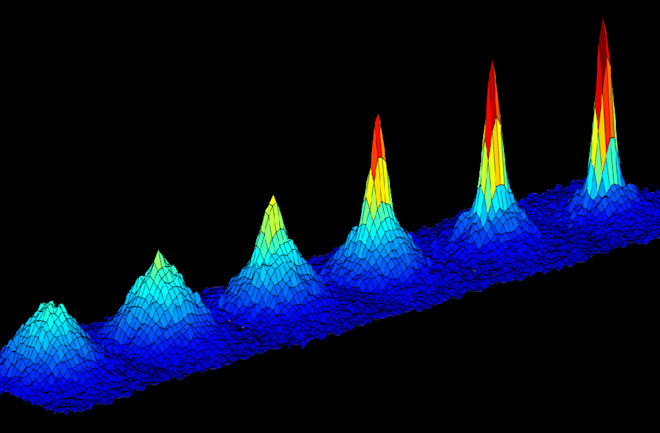Temperature tends to be relative — the air is below freezing, her fever is above normal. But scientists probe the extreme ends of the spectrum of what’s called absolute temperature: At the upper limit, absolute hot is a theoretical furnace where the laws of physics melt away. On the flip side, absolute zero — cold so cold there’s nowhere to go but up — is almost within scientists’ grasp.
To understand it, you first need some Physics 101. The atoms that make up matter are always moving. Temperature measures those atoms’ kinetic energy, or energy of motion. The faster they move, the higher their temperature. Absolute zero, though, is almost perfect stillness.
Nothing in the universe — or in a lab — has ever reached absolute zero as far as we know. Even space has a background temperature of 2.7 kelvins. But we do now have a precise number for it: -459.67 Fahrenheit, or -273.15 degrees Celsius, both of which equal 0 kelvin.
Different materials vary in how cold they can get, and theory suggests we’ll never get to absolute zero. But with an arsenal of new tools and techniques, scientists inch ever closer to reaching that rock bottom.
Why It Matters: Superfluids and Other Material Gains
Bose-Einstein Condensate (BEC): In 1995, University of Colorado Boulder physicists observed BEC, a fifth state of matter that only exists within a sliver of absolute zero. At such a low temperature, individual atoms overlap so much that they collapse into a single quantum state where they collectively act as a single entity. The discovery of BEC opened a new field of science in which physicists can probe quantum behaviors.
Quantum computing: Instead of relying on bits, the 1s and 0s that regular computers use, quantum computers use qubits to make calculations. In theory, these machines can conquer problems much faster than today’s computers. But to work, their atoms or molecules must be cooled to a couple hundredths of a degree above absolute zero, a realm where quantum features aren’t lost in the electrical noise that heat can create.
Material weirdness: When helium gets cold, it gets weird: It can glide friction-free through narrow tubes, sustain currents for long periods of time and flow up and over a container’s sides. Scientists describe it — and some ultracold gases, like BEC — as a superfluid. In recent years, they’ve suggested superfluids might exist in neutron stars, the small, dense relics of supernovas not massive enough to form a black hole. Superfluids have also led to the discovery of supersolids, which have the odd property of being able to flow through themselves. These materials let scientists probe fundamental mysteries of nature.
The Coldest Natural Place in the Universe
Although temperatures plummet on the dark side of the moon and the shadowy craters of Pluto, those locales look balmy compared with the Boomerang Nebula. About 5,000 light-years away, this star system is just 1 kelvin above absolute zero.
How to Get There: Let Lasers Be Your Guide
To sneak up on absolute zero, scientists have used vacuums and lasers in elaborate experiments to cool atoms of a gas. A vacuum can cool a gas without condensing it into a liquid or solid — as would normally happen — but its atoms still move. That’s where lasers come in.
When an atom absorbs a light particle, or photon, from a laser, it emits another photon. When physicists tune the lasers in just the right way, an atom traveling in one direction absorbs one photon and then emits another in a different direction and at a higher energy. The atom will then slow down, photon by photon. By catching an atom in the crosshairs of multiple lasers, researchers can decrease its momentum from every direction. This technique, first used in the 1970s, is called laser cooling.
But there’s a way to go even lower. A technique called evaporative cooling siphons off a gas’ highest-energy atoms — like soup cooling by releasing heat as steam. By combining lasers and evaporative cooling in new ways, scientists have chilled gases to about 50 trillionths above 0 kelvin. It’s not zero, but it’s close.
Race to the Bottom
1926: Chemists first describe a method, called adiabatic demagnetization, that uses magnetic fields to cool materials below 1 kelvin. In 1933, scientists employ it to chill a salt to 0.25 kelvin. That’s low, but not as low as laser cooling can go.
1978: First demonstration of laser cooling takes materials to 40 kelvins; 10 years later, physicists use laser cooling to achieve 43 millionths of a kelvin.
1997: Three physicists share the Nobel Prize for inventing laser cooling.
2015: Stanford University researchers chill a gas made of rubidium — a soft metal used to make solar cells — to 50 trillionths of a degree above absolute zero, setting a new record.
2017: Physicists at the National Institute of Standards and Technology in Boulder, Colorado, chill an aluminum membrane to 0.00036 kelvin, lower than theory predicted possible for the material. The experiment suggests a way to see quantum effects, like a single object coexisting in two places at once.

